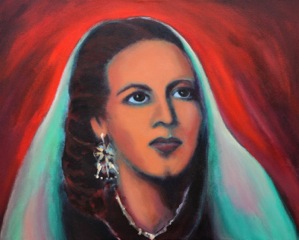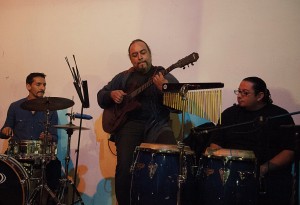This year’s Festival de Cine Todos Santos poster features the image of “María Félix, La Doña,” painted by local artist, Jill Logan, who has donated this piece for this year’s festival Silent Auction. You can view this beautiful painting at Galería Logan in Todos Santos and place a bid, minimum bid $1,500 USD. All proceeds from this auction support the “Youth In Video” educational program. The Final bid reception is at Galería Logan on Tuesday, March 6th from 4:40 to 6 pm.
by Jill Logan
 Often I say I am going to paint more females, yet I go to my studio and paint everything else. When Sylvia and Leonardo Perel approached me to do a painting for the auction for the Festival de Cine de Todos Santos in February, we decided that the subject would be an actor and chose “María Félix ” for the legend she created and, ultimately, for her beauty. It was a challenge I hoped I could rise to.
Often I say I am going to paint more females, yet I go to my studio and paint everything else. When Sylvia and Leonardo Perel approached me to do a painting for the auction for the Festival de Cine de Todos Santos in February, we decided that the subject would be an actor and chose “María Félix ” for the legend she created and, ultimately, for her beauty. It was a challenge I hoped I could rise to.
This Art Talk is dedicated to María Félix the woman and actor.
“Maria Felix,” who died at age 88, was widely agreed to be “the most beautiful face in the history of Mexican cinema.” She became an icon during its golden age in the 1940s–a period of resurgent national pride–and the incarnation of the strong, sexual woman, who would, nevertheless, be tamed by machismo before the end of the movie.
She was born in Alamos, one of 16 children, her father, a farmer and sometime government official, was a strict disciplinarian who did not let his children talk at the dinner table.
Young Maria preferred riding horses and climbing trees on her grandparents’ ranch to studying poetry or taking piano lessons and was expelled from several schools for unladylike behavior. When she was 13, by which time she was already turning heads, the village priest kissed her on the mouth, in her autobiography she recalled how she slapped him and walked out of church, but did not tell her parents.
Her family moved to Guadalajara, where she married Enrique Alvarez, a cosmetics salesman. The union did not prosper, partly because she loved to flirt and partly, she said, because he was cheating on her. After moving to Mexico City, she worked for a plastic surgeon who used her as a model to attract clients.
In 1942 she made her first film, El Peñón De Las Ánimas alongside the famous actor and singer Jorge Negrete, whom she later married. It was with her third film, Doña Bárbara (1943) that Felix’s star began to rise, and according to one critic, “as both a respected actress and an over-determined icon”–however there were some who doubted her acting abilities. Doña Bárbara tells the story of a Venezuelan woman, raped in her youth, who runs her ranch despotically while dressed in men’s clothes (a characterization she was to repeat in La Monja Alferez in 1944) and dabbles in witchcraft. Felix grabbed the role full force becoming the personification of Doña Barbara and, ironically, of Mexico. To the end of her life, she was referred to as Doña Barbara, and her subsequent roles built on the image.
Based on the novel by Romulo Gallegos, the Venezuelan author who co-wrote the film script and welcomed the casting of Maria Felix, Doña Bárbara gave the actress the haughty, self-contained persona that she would continue to develop over the next decade, In 1943, she made La Mujer Sin Alma, the story of a woman who lies her way to the top in urban Mexico, and a string of films that followed, including the celebrated Rio Escondido (1947), where she played with this same image.
Enamorada (1947) was a welcome relief from iconic melodramas. A delightful comedy, with a “Taming of the Shrew” theme, it tells of a rebel leader (Pedro Armendáriz Sr.) falling in love with the daughter of a powerful landowner (María Félix played the daughter). His overtures are ignored, and he suffers humiliating (but very funny) encounters–though, as with Shakespeare, in the end, the heroine is tamed and nationhood re-enforced. In one scene, the cinematographer Gabriel Figueroa focuses ever closer on Felix waking in bed, ending with a shot of just her eyes and nose–an iconic and beautiful image.
“I always chose my men,” Maria Felix said. “I have waged many difficult wars to defend my liberty. Love is also a war.” She admitted that men had in general “treated me fabulously well. But sometimes I had to hurt them to keep them from subjugating me. I have been a woman with the heart of a man. A woman of war.”
Felix made 18 films during the 1940s, and continued to work in Mexico until 1970, by which time she had completed 47 movies. She worked in Spain, Italy and France, with such directors as Jean Renoir (French Cancan, 1954) and Luis Buñuel (Los Ambiciosos, 1959), though most of her European work was disappointing.
She appeared once on the silver screen with Dolores del Rio in La Cucaracha, (1958), and in a play with her by Carlos Fuentes, Orquideas A La Luz De La Luna (1982). She did a television series, La Constitución (1970), won three Ariel awards for best actress, and, in 1985,received a lifetime achievement award and the Mexico City Prize. In 1996, she became the first Latin American woman to be made commandeur de l’ordre des arts et des lettres by the French government.
Apart from her professional career, Felix was often in the news. She was married four times, first to Enrique Alvarez (1931-38), with whom she had her son. On their divorce, Alvarez kidnapped the child, who was rescued by Felix and her second husband (1943-47), the singer-songwriter Agustin Lara. Her third husband, Jorge Negrete, died of hepatitis 14 months after their marriage in 1952, and, on her return to Mexico with his remains, she was criticized for wearing trousers. Her fourth husband, a Swiss businessman, Alex Berger, whom she married in 1956, died in 1974.
Felix was much painted by famous artists, including Jean Cocteau and Diego Rivera (one of her numerous ex-lovers), who, to her fury, portrayed her in a transparent dress. She also inspired many writers, including Octavio Paz and Carlos Fuentes.
She consorted with the rich and famous all her life, was dressed by top designers and, in 1984, was nominated in France and Italy as one of the world’s best-dressed women. King Farouk of Egypt allegedly offered her Nefertiti’s crown for one night of love.
Felix collected porcelain, carpets, jewelry, silver (including a silver bedhead designed by Rivera), cashmere shawls, Chinese costume, books and antique furniture. In 1990, an exhibition of paintings in Tijuana by her much younger lover, Antoine Tzapoff, included a portrait of her astride a rhinoceros. At the same time, there was a retrospective of her more nationalist films and homage to her career.
Felix spent her later years moving between Paris, where she owned a racehorse stable, and Mexico City. She remained the subject of media interest, including a four-hour television program. Paz wrote that she had invented herself; be that as it may, undoubtedly her life was dedicated to maintaining her legend and its myths, both on and off screen.





